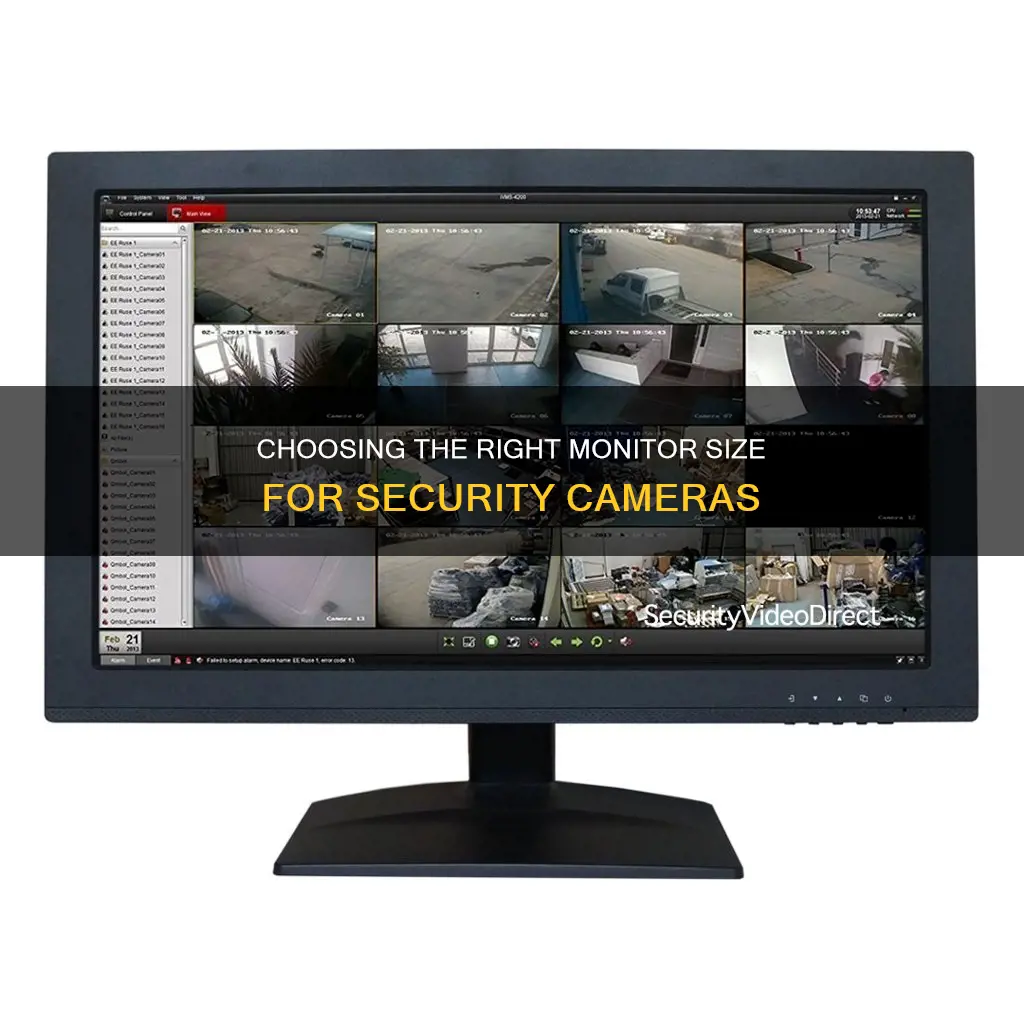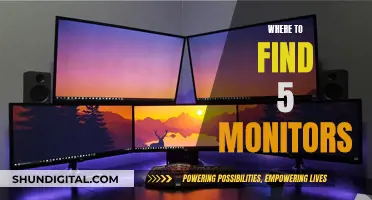
When it comes to security, having the right equipment is essential. For those using security cameras, choosing the right monitor is key to ensuring clear and detailed images. From size and resolution to aspect ratio and mounting options, there's a lot to consider when selecting a monitor for your security setup. So, what size monitor is best for security cameras?
| Characteristics | Values |
|---|---|
| Screen Size | 7" to 42"+ |
| Resolution | HD, Full HD, 1080p |
| Aspect Ratio | 4:3, 16:9, 5:4 |
| Inputs | HDMI, VGA, BNC, RCA, DisplayPort |
| Built-in Features | Speakers, Multiple Video Inputs, Image Enhancement Technologies |
| Durability | Capable of continuous operation in 24/7 surveillance environments |
| Mounting Options | Wall-mounted, Desktop |
| Multi-Screen Displays | Used in advanced surveillance setups |
| Touchscreen Monitors | Available |
| Integration with Video Management Systems (VMS) | Available |
| Energy Efficiency | Energy-efficient models available |
What You'll Learn

Monitor resolution
The resolution of a monitor for security cameras is an important consideration when setting up a surveillance system. The resolution will determine the clarity and detail of the images captured by the cameras.
CCTV monitors come in a variety of resolutions, including HD (High Definition) and Full HD. The higher the resolution, the more information can be displayed on the screen, which is important for security applications where it is crucial to see fine details. For this reason, it is recommended to choose a monitor with a resolution of at least 1080p. A higher resolution will also allow for a wider field of view, enabling the monitoring of larger areas.
When choosing a monitor, it is also important to consider the aspect ratio, which is the ratio of the width of the screen to its height. The aspect ratio of the monitor should match that of the security cameras to avoid image distortion. The most common aspect ratio for security cameras is 16:9, which is also the aspect ratio of 720p and 1080i high-definition network cameras. Therefore, a monitor with a 16:9 aspect ratio is generally recommended.
In addition to resolution and aspect ratio, other factors such as brightness, contrast, and pixel response time can also affect the imaging performance of a security monitor. A monitor with higher brightness and contrast will typically provide better image quality and reduce user fatigue. A fast pixel response time is also important for achieving smooth and clear video footage, especially in high-speed situations.
By considering the resolution, aspect ratio, and other imaging performance factors, you can choose a security monitor that provides clear and detailed images, ensuring effective surveillance for your home or business.
Monitoring Employee Internet Usage: What Employers Can and Can't Do
You may want to see also

LCD panel quality
The quality of the LCD panel is a crucial factor when choosing a security monitor. It determines the video's brightness, contrast, and clarity. The market trend and mass production of LCD panels can also impact their quality. Therefore, it is advisable to opt for well-known brands that offer mature technology and high-quality products.
LCD panels are typically graded into three categories: A, B, and C. Although there is no mandatory regulation, A-grade panels generally have a maximum of one pixel defect, while C-grade panels have more than three pixel defects. It is rare to find LCD panels with no pixel defects, so consumers must carefully inspect the image quality of the product, especially those marketed as A+ grade.
The brightness and contrast of an LCD monitor are also important considerations. LCD monitors with higher brightness levels tend to have more vivid colours and better overall performance. On the other hand, low-brightness products may result in darker images, causing viewer fatigue. A regular monitor's brightness is approximately 250cd/m², and both excessive and insufficient brightness can impact imaging performance.
LCD monitors typically have a contrast ratio of 3000:1, which is higher than that of conventional CRT monitors. However, for video surveillance monitors, a minimum contrast ratio of 400:1 is recommended. If the contrast ratio falls below 300:1, it may not be suitable for security monitoring.
When choosing an LCD monitor for security cameras, it is also essential to consider the viewing angle. Since LCD monitors use different imaging technology, the screen colour can change when viewed from different angles. Therefore, opting for a monitor with a wide viewing angle is generally recommended.
Understanding Trace Free Technology on ASUS Monitors
You may want to see also

Aspect ratio
The aspect ratio of a monitor for security cameras is an important consideration when setting up a surveillance system. The aspect ratio is the ratio of the width of the display to its height and is usually expressed in the format "width:height". For example, common aspect ratios include 4:3 and 16:9.
The choice of aspect ratio depends on the video format and the type of cameras used. If the aspect ratio of the front-end and back-end equipment does not match, image distortion will occur, impacting the performance of the video monitoring. Therefore, it is important to ensure that the aspect ratio of the monitor is compatible with the cameras in the surveillance system.
The most widely used aspect ratio for security cameras is 16:9. This is because most high-definition network cameras, such as 720p and 1080i, use the 16:9 format. As a result, it is highly recommended to use a 16:9 aspect ratio when choosing equipment for a surveillance system.
In addition to the standard 4:3 and 16:9 aspect ratios, there are also other aspect ratios available, such as 5:4. However, it is important to note that the choice of aspect ratio should be based on the specific requirements of the surveillance system and the compatibility with the cameras used.
Monitoring Memory Usage: CloudWatch Strategies and Insights
You may want to see also

Brightness and contrast
When choosing a security monitor, brightness and contrast are important factors to consider. The brightness and contrast settings will impact the visibility and clarity of the monitor's display, affecting how well you can see what the camera is capturing.
Brightness refers to the amount of light emitted by the monitor. A higher brightness setting will result in a lighter image, while a lower brightness setting will make the image appear darker. The ideal brightness level depends on the lighting conditions of the environment being monitored. If the monitored area has varying lighting conditions, such as alternating periods of brightness and darkness, the monitor's brightness setting should be adjusted accordingly to ensure optimal visibility at all times. For example, during the day, a higher brightness setting may be preferred, while at night, a lower brightness setting might be more suitable.
On the other hand, contrast refers to the difference in luminance or colour that makes an object distinguishable from other objects or its background. A monitor with a higher contrast ratio will produce images with more vivid colours and better differentiation between light and dark areas. This is particularly important in security camera monitors as it can help to identify objects or individuals in the footage more easily. A higher contrast ratio is generally preferred, as it improves the visibility and clarity of the display. For video surveillance monitors, a contrast ratio of 400:1 is typically considered the minimum acceptable level. If the contrast ratio falls below 300:1, it may be too low to be effective for security monitoring purposes.
It is worth noting that the ideal brightness and contrast settings may vary depending on the specific camera system and the environment being monitored. It is recommended to choose a monitor with adjustable brightness and contrast settings to allow for customisation based on individual needs and lighting conditions. Additionally, it is advisable to consider the viewing angle of the monitor, as the screen colour may appear different when viewed from various angles. A wide viewing angle monitor is generally recommended to ensure consistent image quality from multiple perspectives.
Furthermore, the quality of the LCD panel can significantly impact the brightness, contrast, and overall image quality of the security monitor. When selecting a monitor, it is advisable to choose products from well-known brands, as they typically offer more advanced technology and higher-quality panels. While there is no mandatory regulation, LCD panels are commonly graded as A, B, or C, with A-grade panels having a maximum of one pixel defect, and C-grade panels having more than three pixel defects. Therefore, it is crucial to carefully inspect the image quality, especially when considering products claimed to be of A+ grade.
Monitoring Employee Web Usage: Strategies for Effective Surveillance
You may want to see also

Mounting options
The mounting option for your security monitor will depend on the installation requirements and the size of the monitor. Here are some options to consider:
Wall-Mounted Monitors: This option is suitable for monitors that need to be installed in a fixed location. Wall-mounted monitors can be placed at eye level or higher, depending on the viewing distance and the area being monitored. This option can save desk space and provide a clear, unobstructed view of the monitor.
Desktop Monitors: For smaller monitors, placing them on a desk or tabletop can be a convenient option. This setup allows for flexibility in positioning and can be ideal for spaces where wall mounting is not feasible. Desktop monitors are typically used for smaller-scale surveillance systems or in settings where the monitor needs to be moved or adjusted frequently.
Motorised Mounts: For added flexibility, you can consider motorised mounts that allow you to remotely adjust the position and angle of the monitor. This option is particularly useful for larger monitors or when the viewing angle needs to be changed frequently. Motorised mounts can be wall-mounted or placed on a sturdy stand.
Vehicle-Mounted Monitors: If you require surveillance on the go, vehicle-mounted monitors are an option. These monitors are designed to be installed in motorhomes, trucks, or other vehicles. They are typically smaller in size, ranging from 5 to 7 inches, and are ideal for mobile surveillance and security systems.
Multi-Monitor Mounts: In advanced surveillance setups, you may need to use multiple monitors to display feeds from numerous cameras simultaneously. Multi-monitor mounts can be wall-mounted or placed on a custom-built stand to accommodate the number of monitors required.
When considering mounting options, it is essential to take into account the weight and size of the monitor, the viewing distance, and any adjustments that may be required during operation. Additionally, ensure that the mounting option you choose is compatible with the installation requirements and provides a stable and secure base for the monitor.
Choosing the Right Monitor: Size Considerations
You may want to see also
Frequently asked questions
The size of the monitor depends on the application and the viewing distance. Larger screens are suitable for monitoring larger areas. Monitors can be as small as 5 inches and are ideal for use in vehicles. Large screen monitors of 40 inches or more are ideal for monitoring centres and can display video from several cameras at the same time.
CCTV monitors are specially designed to convert the digital signal from CCTV cameras into a visual picture. They are fitted with BNC connectors that allow for camera-monitor connection. LCD monitors are commonly used for modern CCTV setups due to their thin profile and energy efficiency. LED monitors are also an option and offer improved contrast and energy efficiency.
In addition to size and type, it is important to consider the resolution of the monitor. It is recommended that you choose a monitor that is at least equal to the resolution quality of your surveillance cameras. Other features to look out for include widescreen aspect ratio, compatibility with CCTV system inputs, low response time, high contrast ratio, sufficient brightness, wide viewing angles, durability, and additional features like built-in speakers or multiple inputs.







